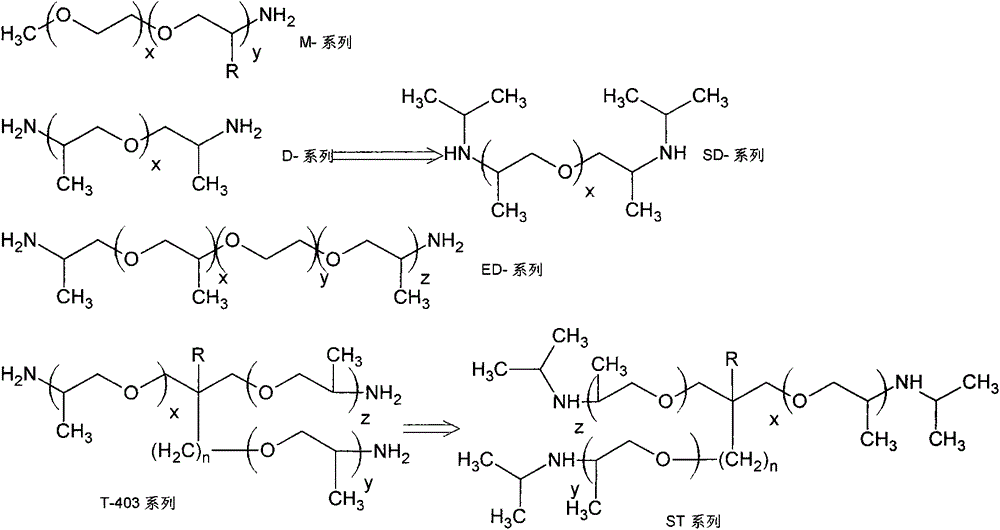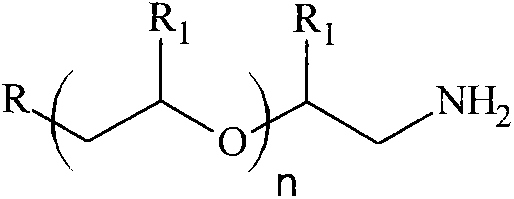A kind of preparation method of bis(alkyl polyoxyalkylene ether) secondary amine
A technology of alkyl polyoxyalkylene ether and primary amino polyoxyalkylene monoalkyl ether, which is applied in the field of preparation of bis-secondary amines, can solve the problems of inability to prepare secondary amine content and lack of secondary amines, achieve less side reactions, The effect of convenient feeding and cost reduction
- Summary
- Abstract
- Description
- Claims
- Application Information
AI Technical Summary
Problems solved by technology
Method used
Image
Examples
example 1
[0046] Add 200g of primary amino-terminated polyoxyalkylene mono-n-butyl ether and 10g of catalyst Raney nickel into a 500ml four-necked flask equipped with a stirrer, a thermometer, a gas conduit, and a straight condenser tube. The molecular weight of ethylenic mono-n-butyl ether is 1646, n(EO):n(PO)=3:1, and the amination rate is 70%. Hydrogen gas was passed through at a flow rate of 110 ml / min, and the temperature was raised to 180° C. at a stirring speed of 300 r / min, and reacted for 5 h.
[0047] After the reaction, the temperature was lowered to below 100° C., the hydrogen flow was stopped, and the catalyst, that is, the bis(n-butyl polyoxyalkylene ether) secondary amine was removed by suction filtration, and the secondary amine content (S%) was 52%.
example 2
[0049] Add 200g of primary amino-terminated polyoxyalkylene mono-n-butyl ether and 10g of catalyst Raney nickel into a 500ml four-necked flask equipped with a stirrer, a thermometer, a gas conduit, and a straight condenser tube. The molecular weight of alkenyl n-butyl ether is 1646, n(EO):n(PO)=3:1, and the amination rate is 70%. Hydrogen gas was passed through at a flow rate of 100 ml / min, and the temperature was raised to 180° C. at a stirring speed of 300 r / min, and reacted for 5 h.
[0050] After the reaction, the temperature was lowered to below 100° C., the hydrogen flow was stopped, and the catalyst, that is, the bis(n-butyl polyoxyalkylene ether) secondary amine was removed by suction filtration. The secondary amine content (S%) was 59%.
example 3
[0052] Add 1000g of primary amino-terminated polyoxyalkylene mono-n-butyl ether and 30g of catalyst Raney nickel into a 2000ml four-necked flask equipped with a stirrer, thermometer, gas conduit, and straight condenser tube. The molecular weight of ethylenic mono-n-butyl ether is 1420, n(EO):n(PO)=3:1, and the amination rate is 92%. Pass hydrogen gas at a flow rate of 200ml / min, raise the temperature to 200°C at a stirring speed of 300r / min, and react for 10h.
[0053] After the reaction, the temperature was lowered to below 100° C., the hydrogen flow was stopped, and the catalyst, that is, the bis(n-butyl polyoxyalkylene ether) secondary amine was removed by suction filtration, and the secondary amine content (S%) was 54%.
PUM
 Login to View More
Login to View More Abstract
Description
Claims
Application Information
 Login to View More
Login to View More - R&D
- Intellectual Property
- Life Sciences
- Materials
- Tech Scout
- Unparalleled Data Quality
- Higher Quality Content
- 60% Fewer Hallucinations
Browse by: Latest US Patents, China's latest patents, Technical Efficacy Thesaurus, Application Domain, Technology Topic, Popular Technical Reports.
© 2025 PatSnap. All rights reserved.Legal|Privacy policy|Modern Slavery Act Transparency Statement|Sitemap|About US| Contact US: help@patsnap.com



